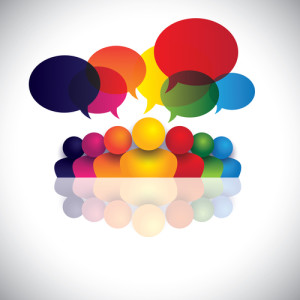I tried to keep quiet. Honest! This executive team did not know me yet and I wanted to get off on the right foot. So I listened patiently, waiting for my appearance in their agenda.

Until I could stand it no longer. That’s when I interrupted.
The team was smart, serious, earnest, and focused. But they weren’t clear. They didn’t have a clear purpose or process. As a result, they were talking intelligently, but going nowhere fast. In just the first five minutes, I had identified five decisions and two plans – seven different threads – under discussion.
They were a bit taken aback when I interrupted. They were indignant when I told them why. But as soon as I itemized the seven threads, they knew I was dead on. On top of that, they were instantly energized. It was as if I had opened the starting gates and turned them loose on a straight track to a finish line that had just become visible in the fog. The clarity I created with my itemized list reduced a complex mess that they could have talked about for hours to seven distinct tasks. And the order in which those tasks needed to be achieved was obvious. The team quickly dispensed with each one, one at a time, in synch with each other like never before.
Fifteen minutes later, those decisions and plans were in place and the executives were ready to move on. Had I not interrupted, my experience tells me the conversation would have circled for another half hour, or however long the leader thought they could allow, nothing would have been decided, and another meeting would have been scheduled.
And these multi-threaded conversations don’t just occur in executive team meetings or any other kind of meeting for that matter. They occur in email, in documents and memos, in phone calls, and in casual hallway conversations. They also occur in every individual’s brain. For example, this article is undoubtedly triggering a number of twisting threads in your brain right now as you try to glean my message while also looking for examples in your own experience.
To understand how ubiquitous and natural these multi-threaded conversations are, consider the following situation. Suppose you and three friends are having lunch. One friend says, “I’m thinking about getting a new car.” Take a minute and imagine the number of different conversations that statement could spawn – the number of questions or opinions that might be voiced and where those first responses could take the group. Keep in mind that just because one friend starts recommending models doesn’t mean another friend isn’t asking about why you want a new car. Here are just a few possibilities, all of which could play out more or less simultaneously. As a matter of fact, the more intelligent, informed, and helpful your friends are, the more threads they will create!
- Are you planning to lease or buy?
- You’re not getting rid of your old MG, are you?!?
- Get a Prius!
- Get a sports car! You’re clearly having a mid-life crisis!
- Who’s going to drive it?
- Are you looking for a new car or used car?
- Would it be for the daily commute or family activities?
- How much money do you want to spend?
- How are you going to put your canoe on top of a sports car?
- You need a red car! Or yellow!
- Red and yellow cars are stopped for speeding the most.
Meanwhile, take another look at the original statement. Your friend hasn’t even decided to get a car, but the advice and questions are already recommending models, colors, and likelihood of getting a speeding ticket.
Now think about recent meetings, formal or informal. Were the opening remarks really that different from your friend’s? Were recent meeting agendas any less ambiguous?
- “We’re thinking about forming a team to improve communication.”
- “You’ve seen the report. What did you think?”
Not convinced? The next time you attend a meeting, try counting the number of different threads under discussion.
While multi-threaded conversations are normal, they are not efficient and effective. They waste time, cause frustration, lead to decisions by exhaustion instead of intelligence, and erode profits.
So how do you prevent multi-threaded conversations that make progress next to impossible?
The short answer is that you must pause before you jump into a discussion and determine as specifically as possible what you are trying to accomplish. The key to clarity and focus is specificity.
To get started, brainstorm a list of questions that must be answered to intelligently address the topic under consideration. Your list might look as random as the new car example above, but that’s OK. Once you have a list, the appropriate order of those questions is usually quite obvious, as are the unnecessary tangents. Now you focus on one issue at a time. If you are working with others, you can truly get on the same page and pool your expertise and brain-power. This is what I did for the executive team mentioned at the beginning of this article. This is what you need to do for yourself and your teams before the horses escape from the barn and start chasing a multitude of interesting, related, but utterly distinct conversations.
This article originally appeared on Forbes.com on September 14th, 2015.


Comments are closed.